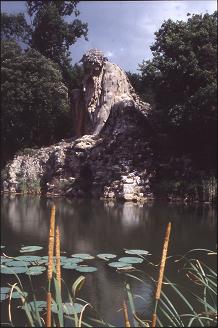- Automata
In the Renaissance, scientists created automata worked by hydraulic systems to adorn gardens: e.g. nymphs moving across a grotto
- Hydraulics and the vacuum
In the 17th century in Florence, in an attempt to raise water for the gardens by means of pumps, the existence of the vacuum was discovered: a scientifically surprising fact, philosophically difficult to admit - nothingness as having a kind of being. It was the study of liquids that led to the discovery.
In the same period, there were poems in praise of 'nothing': a Baroque theme.
see Torricelli's experiment on the vacuum on the website of the Museum of the History of Science in Florence
- Fountain sculpture
an ambivalent sculpture, both focusing on its own material of stone covered with water, and on its representative function - representing an emblematic human figure alluding to the forces of nature:a visual paradox.

- Statues of mountain personifications above fountains
They were made of rough stone which retained the texture of rocks and torrents while representing a giant with shaggy hair and beard seated in the pyramidal form of a mountain, reflected in the pond
a present-day photograph of the statue of the Appennino by Giambologna above the lake in the Medici villa at Pratolino (1579) on the hill north of Florence
- Statues of river gods
They were sculpted so as to evoke flowing drops of water in the motionless medium of stone
a present-day photograph of the fountain at Heidelberg, by Salomon de Caus for the daughter of James I (early 17th century)
- The winding streams
The 'English garden' of the Enlightenment has the serpentine line as its guiding principle , materialised by winding paths and by streams.
on Stowe (Buckinghamshire) see a website on a tour of Stowe.